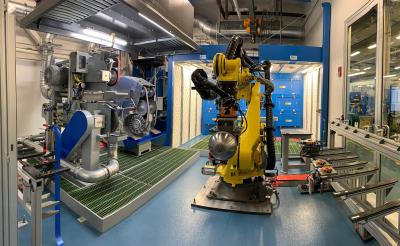
Saint-Gobain Abrasives, one of the world’s largest abrasives manufacturers, has introduced its new Norton Abrasive Process Solutions (APS) Program which was established to help customers determine the optimal grinding or finishing solution for the application at hand, ranging from simple to complex, off-hand or automated, and for metal fabrication, production grinding and virtually any abrasives operation. The APS Program draws upon the vast knowledge of the Norton team along with access to 30 different machines, and a new state-of-the-art APS Robotic Automation Cell, which is at the core of the new APS Program located at the Higgins Grinding Technology Center in Northborough, Massachusetts (U.S.A.). The APS team provides abrasive process development, optimization, automation and in-house testing. APS services encompass the testing and optimization of new abrasives, improving quality and/ or throughput, and trying entirely new and customized processes.
The new APS Program is positioned to be an extension of the customer, where tests can be conducted so that customers do not have to re-assign limited in-house resources and pause their own production. “At a time when North American manufacturers need to deliver high-quality products faster, while stressed with labor shortages, we are thrilled to announce the new APS Program which can relieve some of their burden,” said Tony Landes, APS Lead, Norton | Saint-Gobain Abrasives. “The APS Program is uniquely setup to deliver a comprehensive array of services, including a quick response and short turnaround. The APS team can provide the broadest array of grinding and finishing process development solutions for any type of abrasive.”
The APS Automation Cell is capable of delivering abrasive-to-part and part-to-abrasive applications, wet/ dry processing and uses a full range of abrasives such as coated, non-woven, thin wheel, bonded and superabrasives. Equipped with a verified turnkey solution, manufacturers can then contact an automation system integrator to implement the solution. This avoids costly trial and error at the integrator level.
About the Robotic Technology
The automation cell features an industrial robot with a 210-kg load capacity that allows the APS team to perform processes using nearly any size part or tool. The force sensor-capable robot performs in a multi-capacity role, meaning it is fitted with an end-of-arm gripper to allow for part-to-media processing, as well as tool changers that use traditional hand tools to perform abrasive-to-part processing.
An integrated robotic-centered process development system includes a programmable pivot table, 6-inch-deep coolant pans, abrasive tools, toolholders and radial compliant devices. Spindle motors and compliance slides as well as two heavy-duty grinding heads which have a 15 and 40 hp motor, respectively, are also in the mix. A programmable pivot head with dual belt and wheel is also offered. Belts, cut-off wheels, and grinding wheels for example, can all be accommodated on the stacked head for part-to-media applications that require heavy pressure such as casting cut-off and gate grinding. A side-by-side spindle head can use two belts and up to four radial wheels, which can produce high surface finishes by buffing or using filament brushes.
Contact Details
Related Glossary Terms
- abrasive
abrasive
Substance used for grinding, honing, lapping, superfinishing and polishing. Examples include garnet, emery, corundum, silicon carbide, cubic boron nitride and diamond in various grit sizes.
- buffing
buffing
Use of rapidly spinning wires or fibers to effectively and economically remove burrs, scratches and similar mechanical imperfections from precision and highly stressed components. The greatest application is in the manufacture of gears and bearing races where the removal of sharp edges and stress risers by power methods has increased the speed of the operation.
- coolant
coolant
Fluid that reduces temperature buildup at the tool/workpiece interface during machining. Normally takes the form of a liquid such as soluble or chemical mixtures (semisynthetic, synthetic) but can be pressurized air or other gas. Because of water’s ability to absorb great quantities of heat, it is widely used as a coolant and vehicle for various cutting compounds, with the water-to-compound ratio varying with the machining task. See cutting fluid; semisynthetic cutting fluid; soluble-oil cutting fluid; synthetic cutting fluid.
- grinding
grinding
Machining operation in which material is removed from the workpiece by a powered abrasive wheel, stone, belt, paste, sheet, compound, slurry, etc. Takes various forms: surface grinding (creates flat and/or squared surfaces); cylindrical grinding (for external cylindrical and tapered shapes, fillets, undercuts, etc.); centerless grinding; chamfering; thread and form grinding; tool and cutter grinding; offhand grinding; lapping and polishing (grinding with extremely fine grits to create ultrasmooth surfaces); honing; and disc grinding.
- industrial robot
industrial robot
Robot designed for industrial use. Primarily used as a material-handling device but also used for changing tools, assembling parts, and manipulating special tools and measuring devices. Depending on design, an industrial robot can be programmed to perform a task by means of a controller, or it can be “walked” through the required movements by utilizing a digitizing system that translates movements into commands that the robot can be “taught.” See robot; teaching pendant.
